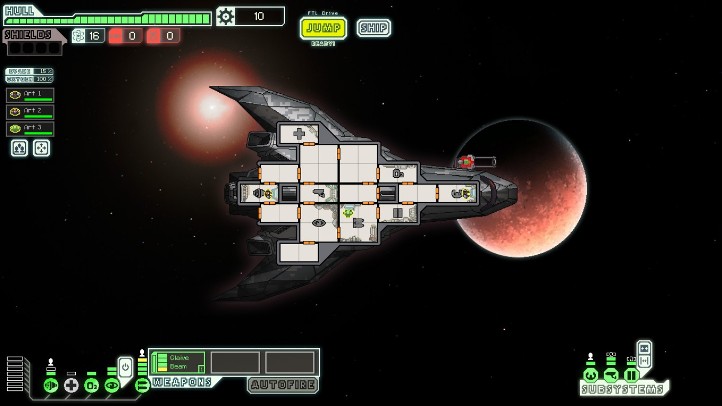Introduction:
Bead Sprites by The Gemsbok
The artistic movement of Cubism has had an incalculable influence on the art history of the past century. Its temporal and spatial fluidity was new and exciting, and carried art yet further along its strange journey of influence from Impressionism toward Abstract Expressionism. Some formal attributes of Cubism, such as flattened perspective plane, an emphasis on forms and experiences over realistic minutiae, a reduction of realistic complexity to geometric simplicity, and sharply contrasting regions of intense color, are also present in a much more recent art form: pixel art.
One recent game which uses pixel art to great effect is Subset Games’ acclaimed strategy roguelike, FTL: Faster Than Light. By taking a quick look at some of the art in FTL, one can acknowledge and remark upon the meaning it carries, in the hopes that others will go on to do the same for pixel art that interests them.
Pixel Art as an Art Movement:
Despite its far-reaching influence and near-constant presence, pixel art is very rarely treated as the movement it is; indeed, the Wikipedia article for pixel art reads more like a technical glossary than a page of information about a type of art like Pop Art or Impressionism.
One does not have to search far and wide for a reason behind this oversight, and many of you probably already have theories as to why this is the case. For myself, I would say that the problem is that Pop Art and Impressionism are movements of (among other things) painting, whereas pixel art is a movement primarily of games. The status of video games as a new art form is itself a controversial topic, and relies heavily upon the degree to which you think art can be (or already is) interactive.

Homme Assis by Roger de La Fresnaye
But setting aside those bigger concerns temporarily, it is most assuredly possible to treat pixel art as a legitimate artistic movement, whether this assessment is ultimately complicated on closer inspection. In a brief demonstration of such a treatment, the validity of the art can be tentatively demonstrated as well.
I have written previously about some ways that the hardware constraints on earlier video games had fortuitous consequences in terms of gameplay, but pixel art is another, arguably much more significant consequence of the limitations of the earliest digital projects. And just like those gameplay elements, many indie games of the past decade have consciously employed what was once only implemented by necessity, and to great effect.
Pixel Art in FTL:
The denizens of the universe of FTL: Faster Than Light are nothing short of impressionistic. Their top-down perspective can be accurately represented by a height by width ratio of about 12 by 17 pixels, and each character is usually limited to shades of two or three colors, plus their outlines. Using that same scale (representing scaled pixels in the above image by individual beads), a human’s face is eight squares of flesh tones. But in these tiny crewmembers one comprehends a reduction to the essential. The spare forms of the different species communicate their roles in broad strokes: power, precision, energy, clumsiness, banality, and more.
There is something symbolic, or inherently inaccurate, to a presentation so utterly sparing and so vibrantly colored. The communication of this notion to much of FTL: Faster Than Light‘s audience is supported by the myriad ways in which different fans have interpreted more realistic renderings of the characters. Just as in Cubism, what is captured is not the image as a photographer would capture it, but as a human could experience it: feelings and impressions inform the art. Perhaps a study of which gameplay styles and which character forms or colors are most strongly correlated to each other would be revealing of cultural attitudes toward body types or potentialities.

Now consider the FTL characters in their natural habitat, situated among the rest of the art in the above screenshot (putting these animated elements back onto their animated canvas). Notice how each character is little more than a speck on the screen, nested within a room square within a room within a room layout within a ship within a background within a UI frame. Note too how the characters, despite being dwarfed by their surroundings, fit naturally into the insulated rooms which contain them. This tension is emblematic of the basic tension of the game, between the construction of a secure vessel for these fragile lifeforms and the intrusion of enemies and enemy fire into that space. Meanwhile, the sharp, clean edges of the indicators, rooms, and menus signify a degree of control; this clarity of presentation is often present in such strategy games, where the player is meant to feel that the world before them is as much their plaything as their responsibility.

Detail of Human
What can not be sensed in this screenshot is the atmospheric, oscillating electronic music of FTL (brilliantly composed by Ben Prunty) with its lulls and swells, providing a further implication of expansive, unknown realms engulfing the ship, which in turn engulfs the characters. This is the experience of sentient adventure and exploration encapsulated, and this theme matches up perfectly with the threatening, unforgiving, and intimidating difficulty of the game.
Conclusion:
All of the utility and emotive qualities of FTL‘s characters, and of their world, are contained within minimal animations of deliberately symbolic art. Artists operating in this style over the past 40 years (first by necessity, and later by convention or by choice) have been accomplishing this same feat of communication by similarly minimal resources. Pixel art shares many of Cubism’s priorities with respect to space, form, color, and light, although it generally does not share Cubism’s emphasis on the experience of time. Perhaps, however, the presence of time is amply provided by any work of art whose experience is itself noticeably protracted through time, such as a film, game, or work of literature.
In light of all of this, I would venture a totally unfalsifiable guess that the public would not have been as readily able to accept pixel art if not for the foregoing century of artistic experimentation. And, above all, I would earnestly hope that pixel art as a movement gets the attention it deserves in the art world some time before all of its greatest or most influential practitioners are retired, or dead.
Related Gemsbok Posts:
Style by Necessity:







![[Topics: Epistemology, Philosophy of Religion, Skepticism] Meditations on Descartes: Examining Objections to the Main Argument of René Descartes’ Meditations on First Philosophy](https://i0.wp.com/thegemsbok.com/wp-content/uploads/2022/11/Photo-of-candle-by-Hartmut-Schmidt.jpg?fit=357%2C400&ssl=1&resize=200%2C200)
![[Game: Dark Souls, FromSoftware, 2011] Unchosen Undead: A Thorough Existentialist Philosophical Analysis of FromSoftware’s Original Dark Souls](https://i0.wp.com/thegemsbok.com/wp-content/uploads/2019/04/Dark-Souls-screenshot-with-Darksign.png?fit=722%2C406&ssl=1&resize=200%2C200)
![[Game: Journey, thatgamecompany, 2012] Not Lone nor Level Sands: A Thorough Ecocritical Analysis of thatgamecompany’s Journey](https://i0.wp.com/thegemsbok.com/wp-content/uploads/2023/12/Journey-screenshot-with-initial-view-of-the-mountain.png?fit=722%2C406&ssl=1&resize=200%2C200)
![[Work: Nausea, Jean-Paul Sartre, 1938] Meeting Angst and Despair: A Brief Introduction to the Symbols and Revelations to be Found in Jean-Paul Sartre's Nausea](https://i0.wp.com/thegemsbok.com/wp-content/uploads/2016/01/Jean-Paul-Sartre-2.jpg?fit=278%2C390&ssl=1&resize=200%2C200)